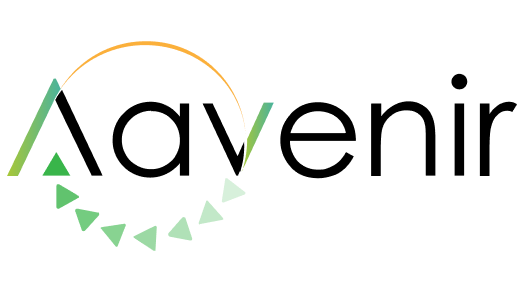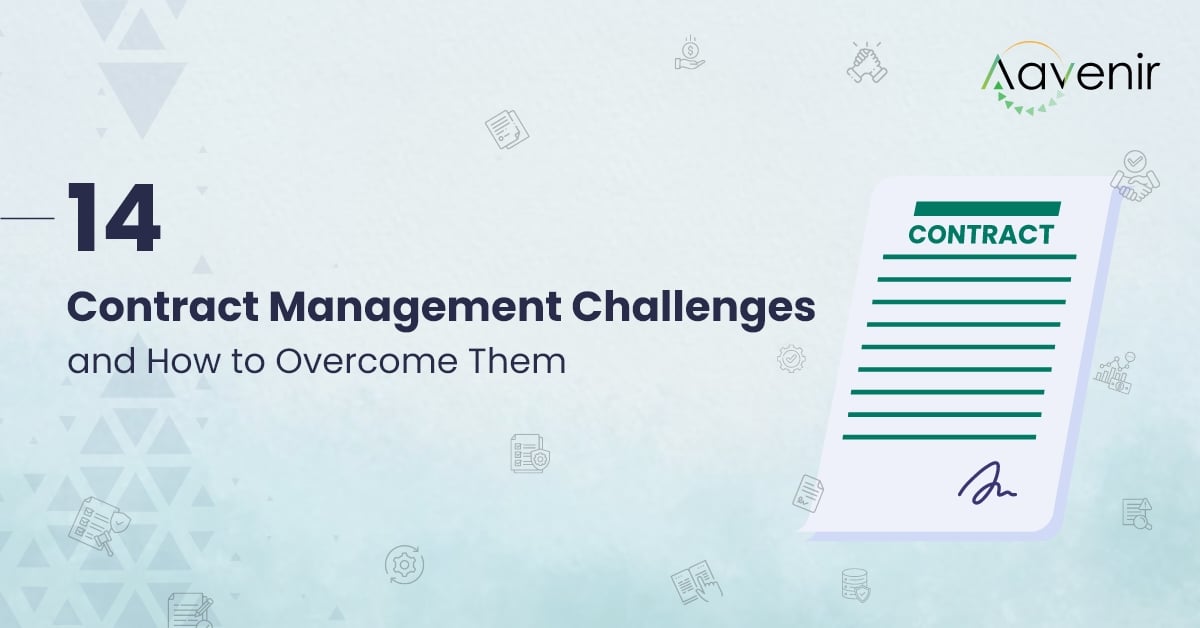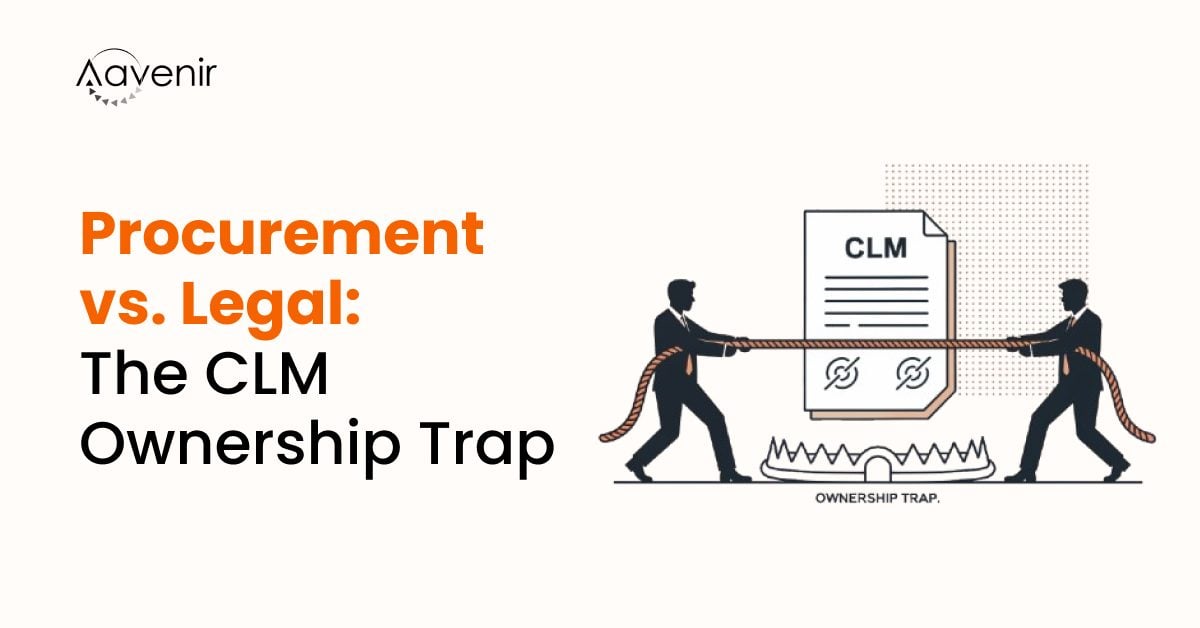Inefficient contract management processes impede an organization’s progress toward achieving its strategic objectives. With organizations managing a growing volume of contracts across departments like legal, procurement, and finance, the risks and inefficiencies tied to manual contract management have become more apparent. Expanding regulations, heightened security requirements, and diverse sets of obligations make it more challenging for businesses to handle these legal agreements.
These complications hinder productivity, lead to slow decision-making, and impact the quality of services delivered across the organization. When unchecked, these could lead to missed opportunities, strained stakeholder relationships, and legal penalties.
This article will explore 14 common contract management challenges organizations face and how the right CLM can mitigate risk, enhance productivity, and drive more value from every contract. Understanding these challenges well is crucial to addressing them and effectively retaining productivity and performance.
14 Key Contract Management Challenges
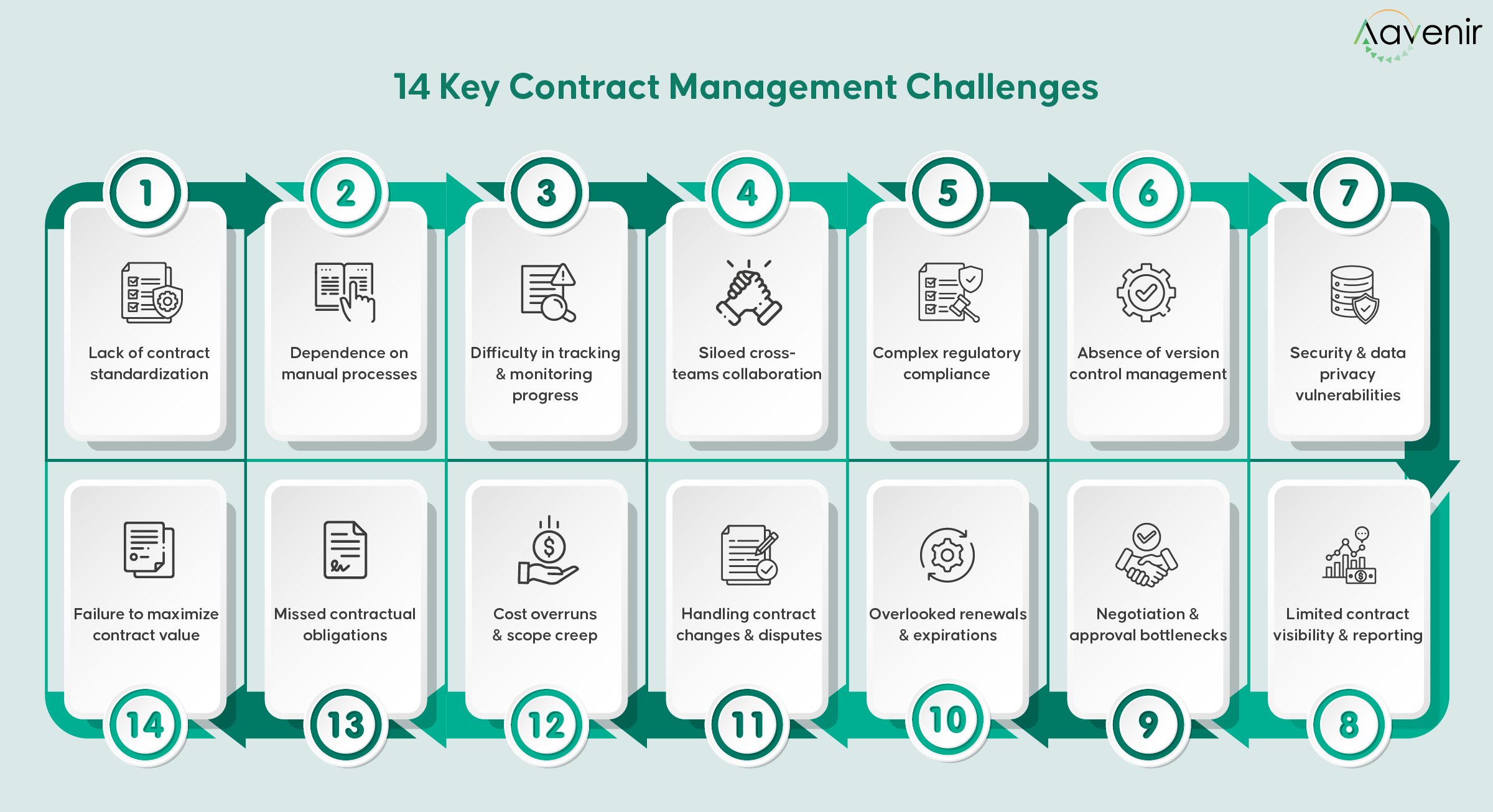
1. Lack of Contract Standardization
The contract management workflow for any organization should be uniform, from contract templates to policies and approval processes. This is crucial to ensuring consistent service delivery and efficient contract management.
The lack of a standardized contract management process can increase the possibility of misinterpretation of the clauses, leading to unrealistic expectations. Stakeholders may expect different outcomes than they thought they agreed to.
Therefore, organizations must adopt comprehensive templates with predefined terms and clauses to overcome this. It can be advantageous to leverage a CLM solution that simplifies the creation and democratization of a pre-approved clause library.
This approach helps eliminate ambiguity between teams, departments, and stakeholders across contracts.
2. Dependence on Manual Processes
The Contract Management process comprises a series of tedious or ‘boring’ tasks such as drafting contract documents, entering data, and following up with stakeholders for feedback. Although each action item is simple, they require keen attention to detail, making them time-consuming.
When rushed, it opens the door to manual oversights such as misplaced information, unexpected delays, and inconsistencies. This not only slows the overall project timelines but also creates compliance risks.
Contract lifecycle management platforms can help by automating such administrative tasks. Teams can set trigger-based automation or incorporate AI to speed up repetitive and patterned action items like creating documents, summarizing contract progress, and sending reminders to third parties.
This frees up the time of various departments, allowing them to focus more on strategic tasks like relationship building while minimizing the risk of human errors.
3. Difficulty in Tracking and Monitoring Progress
Tracking contract deadlines, milestones, and critical dates related to operations like expiry, renewal, and termination can be difficult. This is particularly true for teams and departments handling multiple projects concurrently.
Without a reliable compliance monitoring system, organizations risk missing key deadlines. Repairing these mistakes is even more challenging as teams need to run helter-skelter to meet obligations while ensuring other operational disruptions stay away.
A quick and easy fix to this problem is to use the automated alerts and custom dashboard features of contract management software. Departments and external stakeholders can get end-to-end visibility of the process at a glimpse and will be informed of the upcoming tasks ahead of schedule.
The dashboard also simplifies contract lifecycle planning, allowing teams and third parties to set realistic deadlines that will not need to be modified later.
4. Siloed Cross-Teams Collaboration
As mentioned earlier, multiple cross-functional departments work together to create and execute a contract. The contract documents flow from one team to another in a particular sequence, which requires clear and efficient communication.
However, the processes can get siloed considering contract management teams use different tools throughout the lifecycle. This prevents the timely sharing of information and efficient handovers, leading to approval bottlenecks and missed deadlines.
The underlying cause of this challenge is the usage of multiple software for different phases of contract handling. For instance, separate tools for review and approval may be used, which adds to the overall inefficiency.
Teams can navigate this by leveraging contract lifecycle management software that allows stakeholders to collaborate throughout the contract lifecycle on a single platform. Everyone can access the latest document versions, track approvals, and coordinate better with one another.
5. Complex Regulatory Compliance
Laws around contract governance — such as data protection, employment standards, and industry-specific regulations — evolve frequently. The evolution of these laws has accelerated in recent years due to the emergence of disruptive technologies like artificial intelligence (AI).
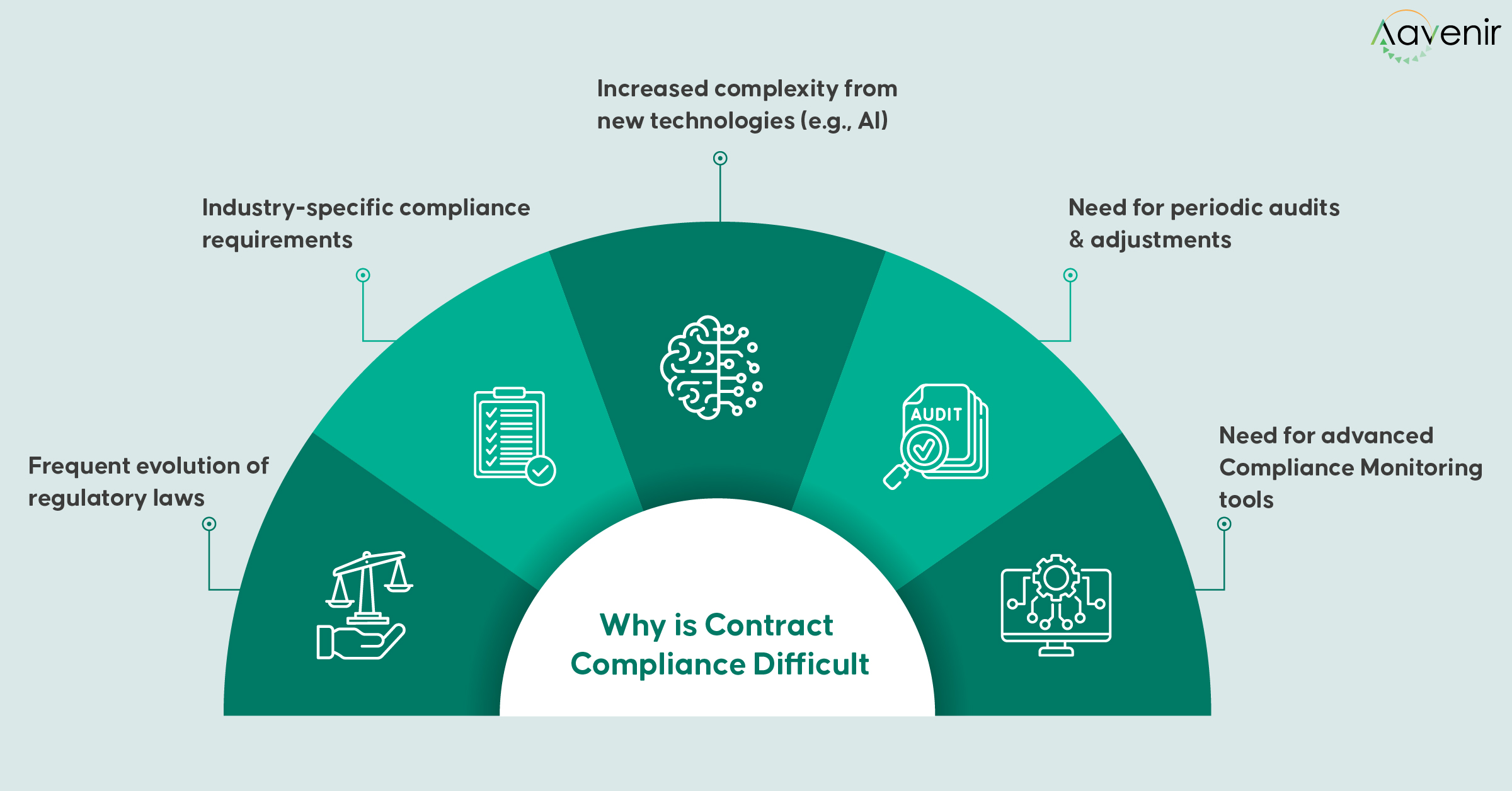
Companies know the consequences of failing to keep up with these regulatory changes. These include legal fines, financial losses, and reputational damage. They can also affect client and stakeholder trust in the long term.
Contract management teams must conduct periodic audits of their contracts and management workflows. This will help them discover whether the in-use clauses and policies adhere to the updated laws in their and their stakeholders’ jurisdictions.
Moreover, modern CLM solutions feature AI monitoring capabilities that evaluate the existing process (and documents) to flag areas of concern. Legal professionals can quickly tend to those sections and make relevant amendments to remain on the safe side.
6. Absence of Version Control Management
Each contract has multiple documents and all of them evolve throughout the lifecycle. The content gets reviewed and edited at each phase of contract management, leading to numerous past, outdated versions.
If stakeholders get confused about which version is the latest one, it will surely lead to miscommunication, disagreements, delays, and frustration. In addition, it will make the concerned departments appear unprofessional, which will affect third parties’ trust.
Fortunately, contract management tools have built-in version control capabilities that automatically display the latest version of all documents within the contract to all stakeholders. Team members can check out past versions if needed to stay abreast of the changes.
A clear version control system on a centralized CLM platform reduces the risk of compliance issues, complicated negotiations, and damaged relationships.
7. Security and Data Privacy Vulnerabilities
Contracts often contain sensitive financial, personal, and legal information. The documents in the agreement should be handled carefully throughout the process to prevent data leaks, corruption, and theft.
Businesses often use multiple tools throughout the contract-handling process while collaborating with multiple stakeholders. This creates numerous access points to sensitive data, leading to privacy risks.
Cloud-based contract management software help navigate this challenge effectively through role-based access controls and a centralized contract management platform. Consequently, only the relevant personnel can access the sensitive documents and can do so in one place.
Apart from encrypting all the agreement documents, the CLM tools also keep a detailed log of who has accessed the contracts and what changes have been made. This is crucial for maintaining high data privacy while encouraging responsible team management.
8. Limited Contract Visibility and Reporting
Organizations with numerous active contracts may struggle to effectively monitor individual agreements’ performances and statuses. Typically, this involves reaching out to various departments and collating the information to gain insights.
This makes it difficult to make informed decisions quickly about compliance, financial obligations, or risk mitigation. Furthermore, it delays daily operations and hides areas of improvement under the surface.
Companies can integrate real-time reporting and analytics solutions into their contract management tech stack. It is better to adopt an end-to-end CLM system that provides custom real-time reports to departments, enabling them to be updated quickly.
The customizability of contract handling software’s real-time analytics capabilities also democratizes data across departments and stakeholders, enhancing transparency throughout.
9. Negotiation and Approval Bottlenecks
Contract negotiations and approvals aren’t straightforward. Before everyone is on the same page, there is a lot of back-and-forth between stakeholders and departments. The approval hierarchies are often complex and can pose as bottlenecks.
Inefficient sign-off processes for the involved third parties and team members can significantly contract finalization. This decreases the overall contract value and increases the pressure on businesses during execution, as they may need help to keep up with ambitious deadlines.
Organizations should implement automated approval workflows. Contract management tools can seamlessly forward the contract documents to the next department or stakeholder in the negotiation or approval workflow.
Another easy method of boosting efficiency in this multilayered process is by eliminating wet signatures altogether. E-signatures hold the same value as physical signatures and take a fraction of time and effort.
10. Overlooked Renewals and Expirations
After execution, a contract is either renewed for the next phase (or project) or expires. In case of renewal, teams need to renegotiate terms to maintain their profitability. Similarly, handling the termination of contracts is crucial to ensure amicability while getting valuable feedback.
Without proactive management of renewals and expirations, things can go awry. For instance, businesses may end up with unfavorable renewal terms, leading to financial losses and frustration. Likewise, with contract termination, improper dealing may lead to reputational damage.
Teams should continuously analyze stakeholder relationships throughout the lifecycle, in addition to closely monitoring the renewal and expiration dates with contract lifecycle management solutions.
This enables departments to fulfil their service obligations on time while staying on top of any potential issues. The proactiveness increases the chances of renewal and a good parting relationship in case of termination.
11. Handling Contract Changes and Disputes
Iterations and edits in contract documents are common in a contract management process. The modifications could be about pricing, or the services delivered. Regardless of the nature of the modification, they need to be properly recorded and communicated.
Additionally, disagreements about the clauses and policies can occur between internal departments and external parties. These need to be handled professionally while aiming for a resolution that everyone can agree on.

Of course, it is easier said than done. However, there are ways in which companies can simplify the process of managing contract changes and disputes among stakeholders.
First, it is crucial to maintain a commonly accessible amendment log that records every suggestion and subsequent edit.
Second, teams need to develop a dynamic, agile, and robust conflict resolution process to work through disputes effectively. The contract document can outline the process to ensure everyone is informed of the workflow. Both solutions can be implemented quickly with a CLM solution.
12. Cost Overruns and Scope Creep
Contract management departments, whether sales or legal, sometimes encounter projects that require more resources than previously estimated. This can happen for many reasons, including sudden changes in requirements, poorly defined contract terms, or insufficient monitoring.
Regardless of the reason, it leads to unexpected costs and resource strain, affecting the contract’s viability and delivery timelines. Occasionally, it may even lead to frustration on all sides, further increasing the likelihood of mistakes and contract failure.
The most important and effective way to navigate this potential challenge in the contract lifecycle management workflow is to be thorough from the start. Teams need to define the scope and cost for all stakeholders from the start.
Moreover, clauses should allow for reconsideration of the budget and timelines if the scope or deliverables evolve. Businesses also need to communicate these details clearly and constantly remain in touch with stakeholders to identify potential deviations early.
13. Missed Contractual Obligations
Contractual obligations go beyond payment, delivery, and compliance. Stakeholders also need to complete tasks associated with maintenance, licensing, insurance, non-compete, warranties, and more.
Each of these obligations is linked to the others. If one of them is delayed, for whatever reason, it starts a domino effect. Consequently, teams and third parties may experience penalties, increased costs, or even legal disputes.
Stakeholders can navigate this one of the crucial challenges of contract management by leveraging CLM software that helps with task management and reminding various parties of their upcoming obligations. These tools can send notifications or email alerts well in advance, allowing everyone to meet the deadlines.
At the same time, businesses can clearly outline their duties and responsibilities from the start and facilitate collaboration among team members.
14. Failure to Maximize Contract Value
Over time, contracts and agreements lose their value. Market conditions change, needs may evolve, and service quality may have shifted. When these aren’t considered during contract renewal or when new contracts are created, the agreements will yield diminishing returns.
Legal teams in organizations can take several steps to address this challenge effectively. First, they should determine tangible metrics that reflect the value of the contracts over time. Teams could also set up customized dashboards on their CLM tools to track these metrics in real-time.
Additionally, maintaining strong relationships with third parties can make it substantially easier to revisit contract terms to redefine the budget, scope, timeline, and deliverables. This welcomes the opinions of the stakeholders as the parties are willing to continue working with each other.
Wrapping Up
Managing contracts throughout the lifecycle can be challenging. Each step, from version control and compliance to collaboration and value optimization, can introduce delays and risks that can potentially impact relationships.
Leveraging the right contract management strategies can effectively address these challenges in contract management. Teams need to communicate effectively, centralize the workflow, set up monitoring dashboards, and automate tedious tasks to retain efficiency, accuracy, and compliance.
The most critical component of the contract management process is the platform. If various departments and parties work in one place, the overall process will be streamlined. The ideal solution is easy-to-use comprehensive contract lifecycle management software.
Aavenir Contractflow, the AI-powered contract lifecycle management software brings advanced capabilities like automation, real-time tracking, collaboration, secure document handling, audit trails, and more. These functionalities enable cross-functional teams to handle contract management issues with confidence and precision.
Ready to level up your contract management process? Contact us for a free personalized demo.
Frequently Asked Questions
1. What are the most common contract management challenges businesses face?
The most common challenges include maintaining version control, managing compliance, tracking obligations, and ensuring secure data handling. Inefficient processes and poor collaboration can also lead to delays and missed opportunities.
2. How can automation improve the contract management process?
Automation streamlines contract workflows by reducing manual tasks, minimizing errors, and accelerating approvals. It enhances transparency, enables real-time tracking, and supports efficient document management, allowing teams to focus on higher-value activities.
3. What is the role of compliance management in contract handling?
Compliance management ensures contracts adhere to relevant laws and company policies. It reduces risk by helping organizations stay updated on regulations, avoiding legal penalties, and fostering trust with stakeholders.
4. How can organizations ensure data security in contract management?
End-to-end encryption, role-based access, and secure, cloud-based solutions can help organizations secure their data. Teams can easily safeguard contract documents from different cyber threats.
5. What strategies are effective for managing contract renewals and expirations?
Automated reminders and milestone tracking systems enable proactive management of renewal and expiration dates. Regular audits and performance reviews also help teams make informed decisions on contract renewals.
6. What are the challenges faced by managers in prioritizing contract management?
Managers often face challenges in balancing contract volume with resource limitations, maintaining compliance, and ensuring timely approvals. Competing priorities across departments can also impact contract-related tasks.
7. What are the factors that affect contract management?
Key factors include contract volume, regulatory changes, data security needs, and organizational structure. Effective communication and collaborative tools also significantly impact contract management efficiency.
8. What are the 4 blocks of good contract management?
Good contract management relies on standardization, compliance, proactive monitoring, and efficient collaboration. These elements help ensure clarity, reduce risks, and drive better business outcomes throughout the contract lifecycle.
